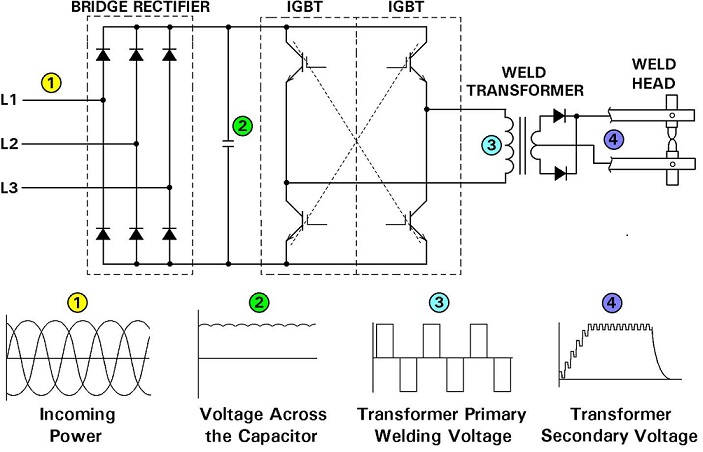In North America, Europe and many other parts of the world AC power is frequently converted into DC at 1000 Hz. This is referred to as MFDC which stands for MID FREQUENCY DIRECT CURRENT. In some parts of the world AC is converted to DC single phase and others to DC at various frequencies higher and lower than 1000Hz. One such MFDC example is DC at 600 Hz.
This 600 Hz output is arrived at by the same processes as all MFDC conversions. There are two components needed to convert standard alternating current (AC) to MFDC. They are the weld control and the transformer. The weld control is made up of two major areas, the first being the Bridge Rectifier where the three phase 60 Hz AC input is rectified into a DC output. The second section is the inverter, or H=Bridge, which is a polarity reversing switch. This switch also operates at the desired increased frequency of 600 Hz. In the H-Bridge the rectified DC input is converted back into a single phase AC square wave output at 600 Hz frequency, as shown below.
This mid frequency AC is the input to the primary of the transformer. The diodes in the transformer then converts this AC back to DC (MFDC) for welding in the secondary circuit.

Power Conversion In Control and Transformer of Mid Frequency Inverter
The advantage of MFDC is that the weld current has no zero cross overs so it heats the part quickly. Also, it is DC so there are no inductive power losses or problems with magnetic material in the welder (machine) throat.
Generally the plant power requirement is reduced substantially with the 3 phase input. Another advantage is robot payload. Higher frequency in the transformer allows the iron core to be smaller. This is a weight reduction which is significant on the end of a robot arm.
Reference: RWMA Manual, Fourth Edition

